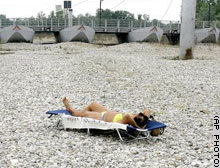
|
| ©AP |
| A woman sunbathes on the dried out Ticino river in northern Italy. |
Farmers have been fretting as Italy's largest river, the Po, has dried up in recent months. The river, running west to east across northern Italy, feeds the broad Po valley which accounts for about a third of the country's agricultural output.
Environment Minister Alfonso Pecoraro Scanio said the state of emergency had been declared as a precautionary measure. It came a day after neighboring France imposed water rationing in several of its regions, also in fear of drought.
Italy's hottest winter in 200 years meant snowfall was light in the Alps, with little snow-melt to swell the Po. Then a hot, dry spring set in, with temperatures in April approaching levels usually seen in June.
But Cabinet Undersecretary Enrico Letta said the latest news of the Po and the water situation in general was "reassuring".
And as the state of emergency was declared, torrential rain was falling throughout the centre and north of Italy. Weather has been generally cooler and wetter over the last week.
The environment ministry was unable to give immediate details of what measures were envisaged.
Officials from the industry ministry, the national electricity grid, regional governments and emergency services met last month to discuss measures to replenish the Po and curb electricity consumption to prevent the risk of summer blackouts.
Drought fears intensified after the Po's level fell by 80 centimeters in late April, to 6.53 meters (21 ft 5.0 in) below its normal level in the northern town of Pontelagoscuro.
Among the measures considered were filling the Po with water flows from large lakes and reservoirs in the Alps, even though it was not expected to bring it back to normal levels.
To minimize the risk of blackouts caused by millions of people cranking up air conditioners, the government may also allow supplies to some industrial clients to be temporarily interrupted, and raise electricity imports.
Around 15 percent of Italy's electricity is produced from hydro-power generation. Water supplies are also essential in thermoelectric plants.
Flowing for 650 kms (406 miles) from the Alps to the Adriatic Sea, the Po has made the region it crosses Italy's most fertile agricultural region and helped turn the north into the country's industrial heartland.
Its delta of 70,000 square km houses thousands of rice, maize, tomato and melon cultivators.



Reader Comments
to our Newsletter